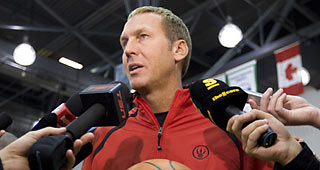Upon his arrival as general manager of the Toronto Raptors, Bryan Colangelo immediately began to overhaul the roster.
Through low risk trades, Colangelo turned Rafael Araujo, Eric Williams and Matt Bonner into Kris Humphries and Rasho Nesterovic. Additionally, he swapped Charlie Villanueva after his promising rookie season for a speedy point guard in T.J. Ford, while signing Anthony Parker and Jorge Garbajosa from European teams. Culminating with the drafting of Andrea Bargnani in 2006 with the first overall pick, these players joined forces with the existing key pieces in Chris Bosh, Jose Calderon and Morris Peterson and went from 27-55 to 47-35 in one season.
The immediate dividends of these rapid changes were two consecutive playoff berths. Although the Raptors failed to make it out of the first round in either season, it seemed that the team was headed in the right direction for the first time since the Vince Carter years.
Unfortunately, the immediate returns and subsequent excitement for Toronto masked a fundamental flaw in the approach of the Raptors: the team had no direction, and as such, no identity moving forward. This lack of identity is what has led the Raptors to their current four-year playoff drought.
Being a “good” team, which is what the Raptors were from 2006-2008 is not an identity. “Good” or “Bad” are adjectives used to describe performance. A team’s identity is intrinsically tied to its best players, and it is up to the general manager to build around the team’s core group of “stars.” The ideology behind this method of team construction is not necessarily to find the best players available, but players that are the best suited to complement the pre-existing core.
For example, the San Antonio Spurs constantly tinker with their supporting cast to surround Tim Duncan, Tony Parker and Manu Ginobli with the right pieces to get back to the finals, while the Dallas Mavericks finally found the right combination to put around Dirk Nowitzki to win it all in 2011.
From his very first draft with the Raptors, Colangelo has failed to do this. At the time of the 2006 NBA Draft, Toronto had a single foundational piece in All-Star power forward Bosh. Rather than trying to pair his sole All-Star with a talented wing player, or perhaps a traditional back to the basket, defensively-oriented center, Colangelo chose to draft Bargnani. The problem with this is not about Bargnani’s talent level or potential, but the limited potential he and Bosh had to coexist.
By using the first overall pick to select a seven-foot perimeter oriented player with three-point range and poor defense, Colangelo showed little long-term vision by effectively wasting the top pick on someone who had many overlapping skills and attributes to his star player. Whereas teams like the Cleveland Cavaliers and Orlando Magic worked tirelessly to surround their young stars in LeBron James and Dwight Howard with complementary pieces that had vastly differing styles to their franchise players, the Raptors foolishly opted for redundancy.
In addition to the lack of a vision, the Raptors' front office has drastically mismanaged roster decisions over the past few years. It is no secret that there are a few franchises that are consistently hot spots for top free agents; Toronto is not one of them. As such, in order to be successful, a franchise like Toronto needs to be aggressive before the trade deadline, draft well, and take some risks in signing talent, even if it means rolling the dice on talented players who have less than stellar reputations. Instead, the Raptors have played it safe in the worst possible way by offering inflated contracts to players who are role players at best. Only for the Raptors is signing Amir Johnson to a five-year $34 million deal on the first day of free agency a success.
The most recent example of the lack of direction that plagues the Raptors can be seen in the decision to draft Terrence Ross with the eight pick in the 2012 Draft. Although many were confused, analysts made sense of the decision by pointing to the slow development of DeMar DeRozan who was in the last year of his rookie deal. The idea then was if DeRozan didn’t take a huge leap forward this year, the Raptors wouldn’t re-sign him and would have Ross as his replacement. This explanation was popular until the Raptors decided to give DeRozan a four-year extension. By committing to DeRozan for the foreseeable future, the Raptors essentially wasted a lottery pick on Ross, who by virtue of playing the same position as DeRozan, will be a reserve at best. The Raptors cannot afford to keep wasting lottery picks, as they may be the only non-playoff team that consistently uses the draft to find role players rather than potential foundational pieces.
Ultimately, as Colangelo’s reign comes to what seems to be an inevitable end, the Raptors are a franchise that has hit rock bottom. The team is near the bottom of the standings, and unlike most of the other teams with whom they share that space, the Raptors don’t have a set, promising franchise player like a Kyrie Irving, Anthony Davis, or even a DeMarcus Cousins moving forward. Poor decisions stemming from a lack of foresight in the front office have left a franchise in disarray and fans in disappointment. Hopefully, the Raptors front office begins searching for an identity and a sense of direction to move forward sooner than later.


